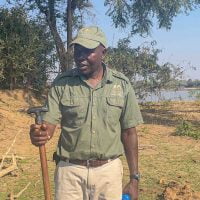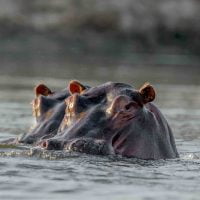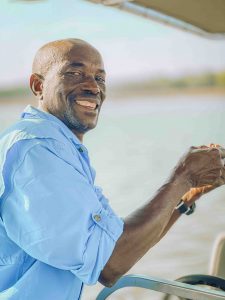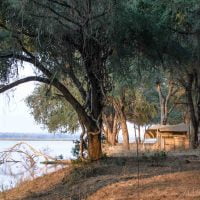This is safari like it was meant to be. Two weeks ago, I had the privilege of spending time in Zambia with Kusini’s newest partner, Classic Zambia. From intimate wildlife sessions with Busanga Plain’s beautiful male lions to playful elephants on the banks of the Zambezi River, this experience takes us back to the roots of safari where wildlife reigns supreme and camp life blends in with nature. There are far too many highlights to cover, so here are my top 5 experiences with Classic Zambia that showed me what they were all about!
Note: For a deeper dive into my experiences with Classic Zambia, read my Kafue and Lower Zambezi trip reports.
1. Walking Safari with some of Zambia’s best safari guides.
It is true that on foot, you will see the little things that you will not see on a vehicle. At Lower Zambezi, one of the directors of Classic Zambia, Kyle Branch, took us on an early morning walk along Kutali Island where the camp is located. Together with a local Zambian Scout, we traversed through the banks of the Zambezi River with the majestic winterthorn forest as our backdrop. Kyle gave us a reader’s digest PhD of the bush; from how essential termites are to the eco-system and how to read animal tracks, to the contents of different animal dung and intriguing animal behavior. There’s a reason why Kyle had a large part in designing the new National Guide Training Program in Zambia and this is personified on a walking safari with him.
In Kafue, I was guided by Gilbert Chiwaya. Not only was he a wealth of knowledge, but his personality made walking under the Zambian sun a breeze! Gilbert was vey good at explaining how different plants are used in the local communities and how the transfer of these ancient knowledge was passed down orally from generations to generations. His storytelling and infectious smile made the safari walks in Kafue even more memorable.
- Hippo Path Explained by Kyle
- Kyle Branch
- Gilbert Chiwaya
- Walking On Kutali Island
2. Paddling on the Zambezi with Skilled Canoe Guides
There is something about canoeing in Zambia that makes your heart race. Maybe it is because the water is filled with intimidating creatures like hippos, crocodiles and elephants and you are going through their territory. However, all of my nerves and anxiety went away as soon as our guide, Richmond, started paddling away. Richmond knew the Zambezi like the back of his hand. The way he navigated the different channels almost made him seem like the Hippo Whisperer. Maybe it was his patience and respect for the hippos, but it almost seemed like wherever we paddled, the hippos and Richmond were communicating and he was asking them to let us through. Canoeing down the different channels allowed us great angles to photograph wildlife as well as the birdlife on the banks of the Zambezi.
His skills were put to test when the sun was going down and the group wanted to take photos of the sunset. Going against the current, he turned the bow of the canoe to face the setting sun and he paddled ever so gently for us to take an amazing photograph of this moment. I can’t tell you how difficult this was! Richmond was paddling against the current to keep the canoe steady for our group to take a photo of the sun setting – hand held (see photo below).
- Richmond
- Canoeing at Sunset
- Eye-level Hippo
- Elephant along Zambezi
- Carmine Bee-eater
3. Fishing
After days of game drives, canoeing and walks, I opted to slow down the pace in one of my afternoon activities in the Lower Zambezi. Lewis, who is one of the veteran coxswain for Classic Zambia took me fishing in hopes of getting a tigerfish. Not only is Lewis one of the best boatmen on the river, he is also an excellent fisherman! We anchored our boat in one of the sandbanks and casted our rods. After a couple of cold Mosi’s, my relaxing afternoon turned action-packed when we finally got a some movement from our rods and reeled in a tigerfish!
As the sun was going down, we decided to cast the last of our bait, expecting to just watch the vibrant African sun set in front of our eyes. But we were wrong. We got into a battle with one of the fiercest fish in the Zambezi River. We caught a Vundu (catfish) and this thing was almost half my size!
- Lewis
- Vundu
- Tigerfish
4. Musekese Conservation
Throughout my travels in Africa, I always appreciated going to camps and lodges that have soul. The activities, food, service and décor of camps have always been great but there is always one element that separates those that can give you a meaningful safari. The Musekese Conservation is the soul of Classic Zambia’s operation. If you want to see why the Directors of Classic Zambia do what they do, make sure to visit the Musekese Conservation headquarters in Kafue.
To put things in perspective, Kafue National Park is the size of Wales or the state of Massachusetts. The area in which Musekese Conservation operate in is just in the North-Eastern section of the park called Musekese-Lumbeya section. This area alone is almost double the size of the Masai Mara Game Reserve. Poaching has been a big problem in this off-the beaten part of the Kafue and since the Musekese Conservation started operating here, we have seen a massive decline in poaching. This is thanks in large part to the strategic operations of the Anti-poaching unit at Musekese.
When talking to Tyrone McKeith, one of the directors of Classic Zambia, all of this anti-poaching work is a great start, but we also need to make sure that we can measure the work that’s being done at Musekese. They want to scientifically prove that their efforts are having a positive impact for the wildlife, so they’ve decided to add a research component to the work done at Musekese. In our visit, Rachel Kabwe, the lead researcher and ecologist at Musekese, showed us the different methods that they use to collect data on all large carnivore and herbivore populations in the Musekese-Lumbeya area. This allows the team at Musekese Conservation to quantify the effectiveness of their anti-poaching efforts and to make informed management decisions on how best to protect wildlife in this area. It’s amazing what this team has accomplished with the limited resources that they are given! This trip is highly recommended to see where part of your tourism dollars are going to.
- Musekese Conservation HQ
- Snare Demonstration
- Rachel Kabwe
- Anti Poaching Unit Base
5. Authentic Camping Experience
What I loved most about my time with Classic Zambia is how they brought back the true essence of what it’s like to spend time in the bush. Connecting back to nature meant disconnecting from our digital world. The very ethos of Classic Zambia is to make sure that they give you an authentic connection to nature by making sure that elements of the camp is as natural as possible. This means bucket showers, minimalistic tent features in Lower Zambezi and traditional Zambian thatched chalets at Ntemwa-Busanga. But this doesn’t mean that comforts are compromised. All properties have flush toilet, incredibly comfortable beds, delicious home-cooked meals, cold drinks and even running water at Musekese Camp, thanks to a natural borehole!
The camp truly comes alive when the guests are gathered by the fire whether it’s during the morning where fresh bread is toasted directly on the fire or exchanging campfire stories as we sip our night cap. Not to mention all your regular visitors around the camp from elephants near the dining area, to hippos chomping away right outside your tent, there is no shortage of wildlife within reach!
- Toasting Bread
- Team at Kutali Camp
- Breakfast at Chula Camp
- Kutali at Sunrise
- Sunset at Busanga Plains
























Leave A Comment
You must be logged in to post a comment.